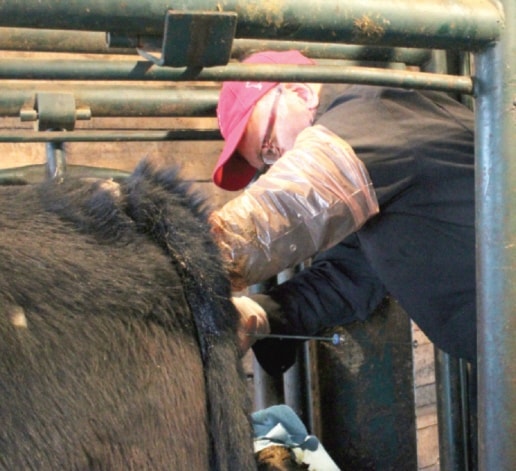For the first time in several years, Mark and Kathy Matejka of Matejka Farms are manually implanting embryos from their finest cows into surrogate mothers.
The expensive process is used by approximately 0.25 per cent of purebred cattle producers in Central Alberta, says veterinarian Bob Janzen. There’s a portion of dairy operations that also take advantage of the technology.
The Matejkas, following the spend money to make money ideology, have been using embryo implantation on and off for the past 20 to 23 years.
“We’re trying to take our best genetic cows and multiply,” said Mark. “(It’s) to improve our genetic gain.”
“We’re selling breeding bulls, it’s basically seed stock,” Kathy added.
After a superovulation process, the selected cows, on average, produce seven embryos. This year the Matejkas got lucky and two of their best produced 27 and 35 embryos. “This (one of the two) cow was an exceptional cow and she’d proved herself with her offspring,” said Kathy.
“If we get five more calves from our best cows . . . Potentially the calves are worth more than if she was having her own normal calf. The potential is there,” Mark added.
Stored in liquid nitrogen, the embryos can be kept indefinitely and pulled for use as needed.
The embryos are extracted from a cow at seven days old and implanted into the surrogate mother who is seven days in heat. “That synchrony is important, between the embryo and the cow,” said Janzen.
During the implantation process, the recently awakened embryo will be gently inserted all the way through the cervix and into the animal’s fallopian tube. This is different from artificial insemination as that process only reaches to the cervix.
“I give them an epidural, so the cows are relaxed,” said Janzen.
The microscopic embryos are kept in special straws, and once ready to be inserted into the cow, they are thawed for 20 seconds then attached to a sheath and round-tipped plunger for ease. Two small holes in the tip help the object travel through the cow’s body.
“The cervix is quite closed . . . It’s really nice to move though,” said veterinarian John Brogan, referring to the holes on the sheath and plunger apparatus.
In the past embryo implantation was a surgical procedure — rather than a small injection — and the side of the cow had to be cut open and the horn of the uterus pulled out in order for it to be reached.
Also, it wasn’t until the late 1970s that the industry began freezing embryos. This not only increased their lifespan exponentially, but helped develop an international market.
Kathy and Mark, who ship their embryos internationally more than domestically, know how much cheaper it is to sell a batch of the unborn offspring than it is to transport a container of the fully grown animal.
